The credo “the only good system is a sound system” in sound system culture will only be an empty or meaningless expression if one does not dig deeper than the surface to get a more comprehensive understanding. One interesting thing to obtain is by looking into the cultural background of its existence.

Sound system is a practical cultural phenomenon which can be said to be the roots or the starting point of Jamaican popular music that we know today. So, it is more than just a speech by DJ and MC. From the perspective of cultural studies and post-colonial studies, the sound system is a counter hegemony towards western epistemology which always dictates world knowledge to be based primarily on visual tradition. Senses in western epistemology are often arranged hierarchically where visual posits a prestigious position. The knowledge emphasizes more on literacy, something that can be seen and read. Visual has always been the foundation of knowledge and spirituality since the time of slavery and coloniality. It is a prestigious symbol of the upper class. Those who had access to education were only the elites. It is a symbol of civilization. On the other hand, illiteracy became a characteristic of the lower-class people. A symbol of marginality, backwardness, and inferiority. To see another possibility that knowledge is not only based on visual but also on sound leads us towards Jamaican tradition, especially sound system culture.
The Jamaican sound system is seen as a case study to theorize how ‘sounding’ can be an alternative mode of knowledge which is dominated by sound rather than visual sense apparatus. With this perspective, ‘sounding’ is seen as a practical cultural analysis of Jamaican culture.
Fundamentally, this sound-based knowledge resonates with the African continent. It became a cultural grounding and point of sonic reference to the development of sound systems or Jamaican popular music in general. There’s an appreciation towards values of sound. When we speak of sound systems simultaneously it goes to song, music and dance through its three main actors: sound engineer, DJ and MC (Master of Ceremony). These three actors of sound systems have previously been discussed in Kultur issues under the title ‘The Founding Fathers.’ This time we will observe three practical elements in Jamaica sound system culture.
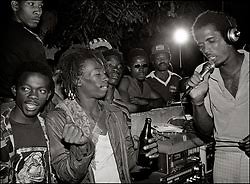
The Chants
Song and chant as the first element consist of oral messages through language. Singing and toasting in sound system culture and Jamaican popular music (ska, rocksteady, reggae and dancehall) are very rich in metaphor in Jamaican creole (Patois), a combination of standard English and several African languages. In the past the slaves were robbed from some different places in Africa and were taken to Caribbean and to Jamaica. They have different culture and language, hence in order to be able to communicate to one another they listened to their master slave’s language (English) and developed it as a means of survival. The presence of Rasta reinforces the position of spoken language as a vital element. It is more than just a means of communication since it also has a power to emancipate people mentally, physically and spiritually. Through this spiritual and social movement, dread talk or Rasta talk (Jamaican dialect) began to establish its existence. Dread talk or Rasta talk is very symbolic and religious. It lifts up Patois to a higher philosophical level. It is meant to heightened people’s inner awareness and sensitivity about the true power of spoken word. A Rasta elder, Bongo Israel said that ‘word, sound, power’ is a symbol of man. Language is used to fight Babylon, “we don’t use sticks nor guns,” language is their weapon. So the tradition of knowledge in Jamaica is nurtured orally through ‘word, sound and power’ not by texts (literacy). The legitimacy of the spoken language is apparent in sound system culture and later reggae which is very rich with verbal creativity in singing, chanting and toasting.

The Music
The next element is music. Being robbed and torn apart from Africa, land of their ancestors, the slaves created various forms of music as a means of communication and source of inspiration. Michael Bokor in his article, ‘When The Drum Speaks’ shares about the tradition of African drum in affecting human behaviour and debunks people’s assumption about drum (percussion) as a mere instrument for entertainment, voodoo and rituals. The article argues that as an artefact drum (percussion) is a substitute of spoken language (drum language) and a primary symbol used for rhetoric goal in influencing social behaviour, increasing consciousness, vigilance, and pushing quick response of self and identity formation. The rhetoric function of African drum and dance is to give another interesting insight of the rhetoric nature in non-Western world.
Jamaican music tradition is heavily influenced by African cultural heritage. Almost every parish in Jamaica has its own traditional music. In St.Thomas and Portland from the Maroons are Kumina, Dinkie Minnie, and Brukin Party. St.James, Hanover and Westmoreland they have Gerreh-benta, Ettu, Nago and Bele. In Clarendon and St.Catherine they have Buru music. In urban parishes like Kingston and St. Andrew they also have traditional music like Puk-kumina and neo-African Rastafarian chants. There are also Gumbe, Tambu, and various styles to the oldest one, Jonkunnu. These traditional music do not vanish from the land, instead they become a bedrock of foundation where the later history of Jamaican music will stand upon. And obviously the exposure to European music of the slave master carried by sailors, soldiers, the clerks with religious chant, recreational song, folk song, ring games also contribute to this formation. However, from all the music and their characteristics above, percussion and drum play the most significant role.
Mento became the first modern music in Jamaica and is also considered as the first national music. It transcends all parishes’ boundaries with their traditional music. Mento introduced dancing space and social gatherings and accompanied Jamaica until the modernization was getting more intense with the presence of radio, record player and cinema. The Jamaican population began to get exposed to various materials from the U.S in the 1950’s and 1960’s. The hybridization process began to blow even fiercer. Jamaica geographically is just a tiny island but as a culture it is a big continent.
Sound system started with the presence of a radio and record player. However, due to poverty not all the people could afford them. Eventually, there were some people who were interested in electronics and they combined speaker to radio or amplifier to bring free access to entertainment for the less fortunate people. The way Jamaicans utilize technology to meet their specific needs is quite unique, different from the countries who manufactured speakers, record players and amplifiers. Jamaica does not manufacture those equipment but the people can fix and build their own sound system. The collection of megawatt amplifiers, massive speaker and record library all available into one institution of sound system which is unique and staggering. The two notable pioneers who developed the sound system are Arthur Reid (Duke Reid of Trojan) and Clement Dodd (Sir Coxsone Downbeat). Music that they played was a collection after visiting U.S like various types in R & b: slow and up-beat waltz, Jazz instrument, Latin Caribbean like mambo, cha cha cha, merengue, mento and calypso.
But when the soundclash got fiercer, came a desire to produce authentic music that is not possessed by other competitors and bring something new to the dance floor. Simultaneously, it stimulates new inventions and creativity into sound system culture. The practice of recycling riddim and voice over riddim triggered the arrival of selector or deejay (DJ) and MC (Master of ceremony). The pioneer of riddim started around the 1960s when Clement Dodd from Studio One recorded vocalists like Larry Marshall to sing over imported records owned by him. But the most notable landmark of the digital use of riddim was in 1985 with Prince/King Jammy and Wayne Smith’s ‘Under Mi Sleng Teng’ riddim. Another significant thing is the presence of DJ and MC as an artist. They would shout out many things ‘pon the mic to big up themselves and the sound system as well as to encourage the crowds while playing records. In the junction of its development in the 1960s the art of deejay and voice over riddim was pioneered by King Stitt and also the outstanding one like U-Roy as well as King Tubby. This trend was strengthened by big names like Dennis Alcapone, Lone Ranger and Dilinger. An offshoot of the sound system is dub. It comprises original remixes of records where sound engineers like King Tubby, Lee ‘Scratch’ Perry or Scientist dramatized the sound effect with faders, reverb, and delay.
The DJ-based riddim-plus voicing format in a form record and live MC toasting on the dance floor has become an idiom of Jamaican popular music. All the elements in sound system culture become a starting point and inspiration to a never-ending creativity in Jamaica popular music (ska, rocksteady, reggae, dancehall). This sonic experience through the sound system triggers a desire to produce authentic music which represents Jamaica. Roger Stefens in his book on Bob Marley’s biography shares a story of Marley’s regular visit to a sound system party in Kingston where he would be exposed to the music realm and nurture his own original version. Songs like ‘Put It On’ (1973)”…Feel like toasting,” and ‘Roots Rock Reggae’ (1976), “…Hey Mr.Music show sound good to me, I can’t refuse it what to be got to be” are the testimony of his exposure to sound system culture. The first traditional music in those parishes are substituted by innovation and technology but still have a connection to the roots of Jamaican culture.
On the other hand, dread talk or Rasta talk to express higher consciousness and awareness upon the power of spoken word is maintained and nurtured in the sound system through DJ and MC’s verbal wit and creative toasting. The sound system culture keeps on changing and adapting from time to time. In the 1970s the heavy influence of Rasta impacted the infusion of spirituality to the music. This Rasta movement also made resistance become an integral part to the music, especially reggae. However, by the 1980s sound system began to focus more on dancehall music which is heavily influenced by American Hip Hop, digital music, street politic, and fashion. And started from the 1990s dancehall as a genre and culture bearing more various styles which according to some music analyst like Morgan, claimed that those new styles had foreshadowed themes like spiritual, politics, and education of the previous era.
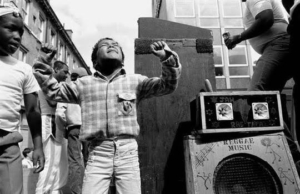
The Dance
The last element is dance. The sound coming out from the speaker and amplifier is a call to gather and connect people, open up for social connection. Besides live bands, today reggae tends to be performed in sound systems. The sound system apparatus, speaker, record decks, and amplifier when played bass and sub-bass at low frequency can communicate a strong vibration to the body of the listeners or audience. But a sound system is more than just a collection of those technical objects. It is also about building up, skill arrangement, and ways to operate those elements into a certain context by the crewmembers, and team or band. This arrangement together with the interaction between performance and audience creates a space for dance. There’s an African proverb which says “If you are such a good dancer, the drummer can have a conversation with you.” Jamaican culture always resonates with Africa. Various music that they produced emphasize more on percussive sound or drum. and they are rhythmical hence they have a strong connection to body movements. Music is one entity with dance and a significant part of Jamaican identity. Without denying the controversy of dancehall upon the issue, Sonya Niaah Stanley, a Jamaican dancehall researcher argued that people have to see the aesthetic of the dancehall from the perspective of Jamaican culture and not from western epistemology. She even makes a strong statement: “If you’re out there making Jamaican music and people can’t dance to it then you’re wasting your energy on a knock off version of Jamaican music which has historically electrified and simultaneously entertained the world.”
In Indonesia alone the development of Jamaican music is quite massive. There are plenty of scenesters scattered throughout the archipelago. Unfortunately, based on Kultur observation the sound system hasn’t got much attention and significant growth. The experiment of sound systems is still using PA (Public Address) through some dub acts individually or collectively in clubs and small venues. Sound system with mobile set up is so far yet to happen. Various factors can be the basic analysis, but perhaps the difference in tradition and culture as well as some government regulation for public activities are among the reasons.
(Yedi)
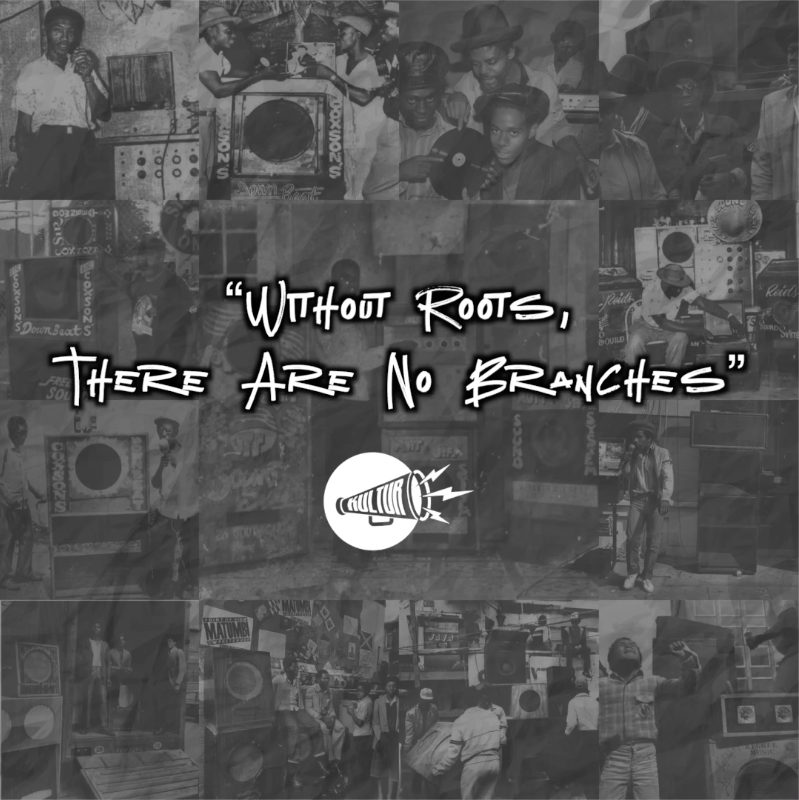


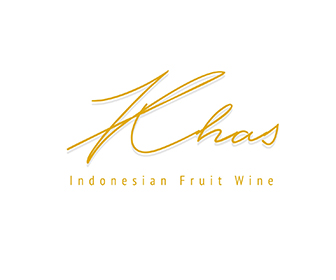
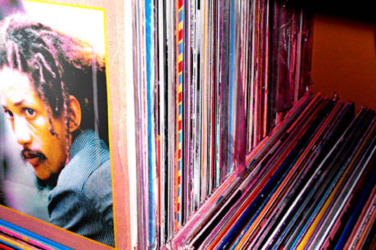
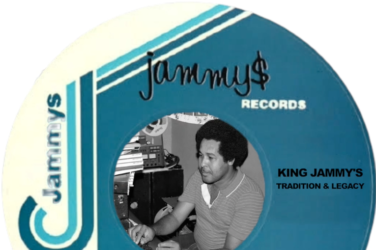

Show Comments (0)